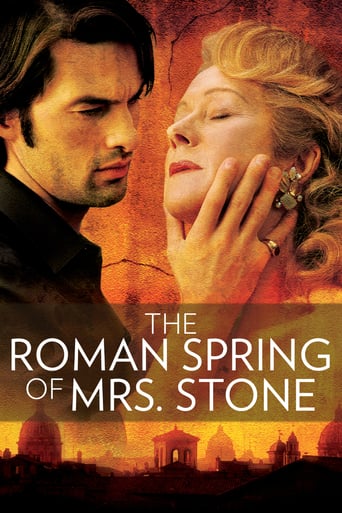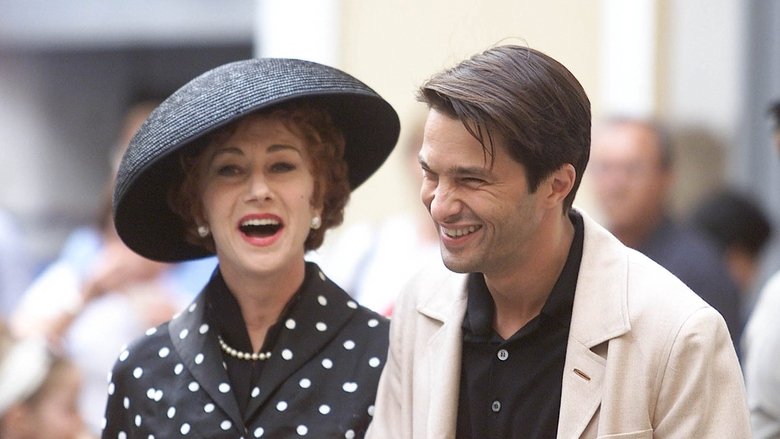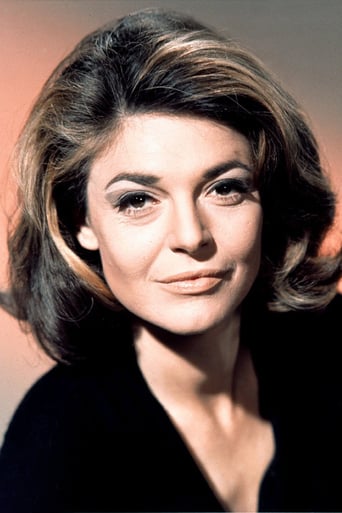The Roman Spring of Mrs. Stone (2003)
An aging actress' husband dies of a heart attack en route to Rome, where they'd planned to holiday. There, she rents an apartment and, through the Contessa, she meets a young man, with whom she begins an affair.
Watch Trailer
Cast
Reviews
Fun premise, good actors, bad writing. This film seemed to have potential at the beginning but it quickly devolves into a trite action film. Ultimately it's very boring.
It's an amazing and heartbreaking story.
It's the kind of movie you'll want to see a second time with someone who hasn't seen it yet, to remember what it was like to watch it for the first time.
It’s fine. It's literally the definition of a fine movie. You’ve seen it before, you know every beat and outcome before the characters even do. Only question is how much escapism you’re looking for.
Anytime you get involved with Tennessee Williams' characters, you are sure to find yourself at 3 AM in the dark night of someone's soul, when the last waltz has already been danced. But that someone is not necessarily a "real" person. Rather, it's a "creation" by an author whose own life was so "unquietly desperate" that reality had not much meaning for him, a fact which is reflected in his "unreal" characters. These "people" of Williams' certainly give and have given a number of actresses considerable work over the years, and Helen Mirren is surely one of the best. This novella is one of Williams' darkest tales, but should not be regarded as in any way a look at reality, unless you conceive that most of the people of this world are certifiably insane, a condition which Mirren limns admirably. Williams, I think, was intent on delineating a world, which he thought of as real, but which probably derived from his worst nightmares, waking or otherwise, could not actually be realistic. A look at this world is not necessarily an "entertaining" experience, and I doubt that Williams intended it to be. So why bother? Well, you can enjoy the work of the actors, if not the story, and you can speculate about the author as I have been doing. As he was a homosexual, I have considerable doubt that Williams can be taken seriously when he deals with women. Yet almost all his protagonists are women. I wonder why. Oh, I haven't even discussed the story, and I don't think I will, except to say it involves a woman whose actions will seem absolutely incomprehensible to us "normal" folk. My rating of 9 reflects mainly my admiration for Helen Mirren's work. Otherwise, the film offers many irritations, which you can select for yourself.
..this is really a stretch, because it has been many years since I saw the film with Viven Leigh/Warren Beatty version. To compare the two versions, not really fair, because THIS "Spring" has such graphic sex-scenes, where as Miss Leigh would hardly have been filmed in such a manner, as I can remember. So, we must write on this particular version, only to say that Beatty was gorgeous, but what a rotten actor in that film. And, didn't "Mrs. Stone" have plastic surgery ????First-off, had I been married to "Tom Stone" (Brian Dennedy), I think I'd have become obsessed with sexual encounters, too. Dennehy was a perfect cast for that role, because he certainly had NO sex-appeal. As others have written, "the animal" was lurking in "Mrs. Stone" (Helen Mirren), who was brilliant in this TV re-make. Although she was never a great beauty, not many actresses will allow themselves to be filmed with age all hanging-out. To me, that aspect was absolutely necessary to fully make her role believable, because that's what the story is about. I don't think too many actresses would be filmed is such sexually orgiastic scenes, either."Paolo" (Oliver Martinez) certainly was engaging in his snooty, macho character. If he's 40-years-old, all men should hope to be so hot-looking, even in this day of gyms and work-outs. His narcissism was brilliantly played, most "users" saying it wasn't acting. Who cares? Actresses use their beauty, too. After all, he was a "conte" ! (some folk may spell it with a "U"). Robert Ackerman may have been reticent about his directing in some scenes, but he certainly knew how to let "Paolo" use his "animalistic" prowess: make the actress drop the script by opening the sheet; a hump in an open auto; "beg", beg"; "let me take-off my grandmother's locket". Wow ! (Similar sexuality in "Primal Fear"). That "Mrs. Stone" was a good business-lady didn't prevent him from trying - I suspect most "marcetta" (gigolos) would have cut-out a long time before he did. After all, he was a businessman, too.....I vaguely remember how wonderful Lotte Leyna was in the original film, but I thought "Contessa" (Anne Bancroft) was marvelous in that role. Her constant eating, when it was free, provided much-needed comedy in such a heavy story. Her slick role was well-played, as was her contempt for American ladies, as was her brow-beating to her guys. Tough luck that "Mrs. Stone" knew the value of a dollar......"The Young Man" (Rodrigo Santoro) was stellar in his role of a homeless man. As several wrote, what a face under all that hair and dirt ! Martin Sherman could easily have insisted that he play the "marcetta", but his face WAS too sweet. He may have been homeless, but he was smart enough to figure-out "Paola" was an employee....next in line? Smart move to urinate for the employer. His attributes wasn't lost on "Mrs. Stone".......the "key scene" was exquisite for "Mrs. Stone" for her realization she was a lost soul, and the humility of the smelly street-man. The fade-out of their faces was genius. That's theater !No one wrote that Roger Allam (the play-writer) could possibly have been playing the role of Tennessee Williams - very good impersonation; I've seen Williams up close many times. He had Brando as a model for "Paola". Nor did anyone mention the all-knowing expression on the hairdresser's face (Sara James), who could have narrated the whole movie with feeling.In retrospect, Mirren was perfect for this role. "Age", not "beauty", was the centerpiece of this story. The costumes were gorgeous and the cinematography very good - I don't remember the score, so it must have been appropriate. Although someone was right about saying a lot of the background was shot in a studio, not in Rome, it was good......this was a TV-movie, guys....... Being faithful in loving the original version, I did not like this movie till the second viewing. I didn't know it was shot for TV, and wondered why anyone would try to re-make such a classic. Trading-off different aspects of the two versions is pointless - this is a very entertaining film. I recommend it for any adult - teenagers already know about all this stuff. I rate this movie as a 10.
Considering this was a made for TV, it does a respectable job of making itself comparable to the Louis De Rochemont-Jose Quintero production of 1961.Tennessee Williams' smarmy tale of the widow and the gigolo is enhanced by a fine cast. Helen Mirren's Karen is less physically attractive than Viven Leigh's, yet she's a strong actress and projects genuine pathos as the pathetic heroine.Olivier Martinez' Paolo is more personable and less edgy than Warren Beatty's, and has a more convincing accent. Anne Bancroft brings her own, distinctive interpretation of the Contessa, comparable to Lotte Lenya's.John Altman's score is serviceable (whereas Richard Addinsell's was hauntingly thematic). More standard is Robert Allan Ackerman's direction, compared to the distinctiveness of Quintero.Being a smaller screen work with a lower budget, this version of "The Roman Spring of Mrs. Stone" adds yet another offering of a basically unpleasant subject. Williams really seemed to like spinning these tales of once-beautiful, aging women, desperate for love and addictively pursuing affection, literally at any cost.
I found myself reminiscing about this film long after having seen it. Initially expecting a probable pale imitation of the 1961 original; it seemed this new film appeared to possess many symbolic occurrences and images that seemed strangely familiar. For example, the homeless man knocking at Karen Stone's door reminded me of a picture I had seen as a child. The caption below the picture read "Look, I am standing at the door knocking. If one of you hears me calling..." Revelation 3:20I also remembered some of Helen Mirren's past performances as characters very unlike Mrs. Stone; therefore it required a preliminary adjustment to accept her as the more sensitive, deeply passionate, fading beauty. However, her outstanding vocal delivery and subtle nuances in voice and movement combined very effectively to bring Karen Stone to life. Karen Stone, a woman bewildered and lost after her humiliating final theatrical performance, the death of her husband and the loss of her youth finds herself "drifting" with no particular focus after finally deciding to settle in Rome. She meets an "old harpy" named the Contessa and her "man for hire" Paolo Di Lio. Olivier Martinez plays Paolo in stereotypical fashion as a vain, arrogant, self-centered rogue and Karen Stone is totally captivated by him. "Love is blind" is truly one of the film's major underlying themes as Mrs. Stone refuses to accept the total reality of her arrangement with Paolo anymore than he fully accepts the fact that he is, in actual fact, a purchased lover. Even Karen's physical appearance changes as her "addiction" progresses to the point where she resembles a heavily made-up caricature of her former self.The films heavily stylized 1950's costuming, artful set decoration, masterful cinematography and haunting, poignant score set against the backdrop of the "eternal" city serve as a very effective combination of elements in creating the films memorable romantic impression.For the most part, the characters are interesting and enjoyable to watch providing one accepts them strictly for who and what they represent. Anne Bancroft as the calculating Contessa appears to have a fun loving side as opposed to Lotte Lenya's vicious ruthlessness in the original film. Coral Browne's performance as Karen Stone's friend in the original film is, however, sadly missed.Rodrigo Santoro's performance as the homeless man presents an interesting character study because of his primary reliance on facial expressions which are powerfully supported by the films unique presentations of symbolism, colour and sound. When Karen Stone first makes eye contact with him on a bridge he responds with a provocative leer and exposes his chest, his hand held over the heart area. This gesture is dramatically different from her initial meeting with Paolo, wherein he lights her cigarette, a probable symbol of a fleeting but fatal pleasure.From the beginning the homeless man appears to be on a quest to establish contact with Mrs. Stone. His motivational perspective as a positive or negative force remains unclear throughout the film. At one point, there is a wonderfully effective camera shot circling around his head as he gazes up at Mrs. Stone on her veranda. An impoverished vagrant, he goes largely unnoticed as he eats scraps off the ground, gets kicked by a police officer, is laughed at by Paolo's barbers and is repeatedly viewed with disdain by Mrs. Stone. Thus begins a series of unexpected but plausible Biblically symbolic references: "...without majesty, we saw him, no looks to attract our eyes, a thing despised and rejected..." Isaiah 53:2 The homeless man's next couple of appearances are lewd demonstrations perhaps meant to reflect Mrs. Stone's "addiction" to physical pleasure at the expense of her personal dignity. Later, Paolo calls Karen to the window and asks her the identity of the man in the street. There are cathedral bells ringing in the distance as she refers to the him using the somewhat unusual description as a probable "money changer." Luke 2:14. When the mysterious man knocks on her door for the last time, Mrs. Stone finally confronts him with her impassioned plea, "Why do you follow me?" He responds with a mute, tear filled expression.The film is brought to a overwhelmingly unhappy, emotional climax at Karen Stone's final "party" when she overhears the Contessa describing her as "a harlot who has struck it rich." Karen looks to Paolo for reassurance. There is none. Mrs. Stone is at last forced to come to terms with the person that she has become.Left alone after throwing out Paolo, the Contessa and friends, Helen Mirren performs a wonderfully effective mime performance as a woman alone and humiliated while pacing around her clock as she silently acknowledges her helplessness over the passage of time.She then wraps the three keys to her apartment in a white handkerchief. Waving the handkerchief like a flag of surrender from her veranda, she throws it down to the homeless man waiting on the street. He takes the keys and looks up, his face a rich tapestry of emotion. As he approaches the first gate to her apartment, a "trinity" of lights shine in the background. In addition, directly behind him an obelisk-like formation reflecting an ice-blue light projects toward the sky resembling a "conduit" of sorts. As he approaches the second gate it becomes apparent that the stairway leading to Mrs. Stone's apartment has become awash in the blue light as well. When he opens her door the light enters her apartment and it also flows in through the windows. The blending of the various colours form an echo reminiscent of a renaissance painting. The homeless man moves silently toward her, his face half obscured in shadows, his eyes a profound reflection of love and understanding.As Mrs. Stone smiles back, the couple's faces go out of focus, as though each person had suddenly ceased to exist.





